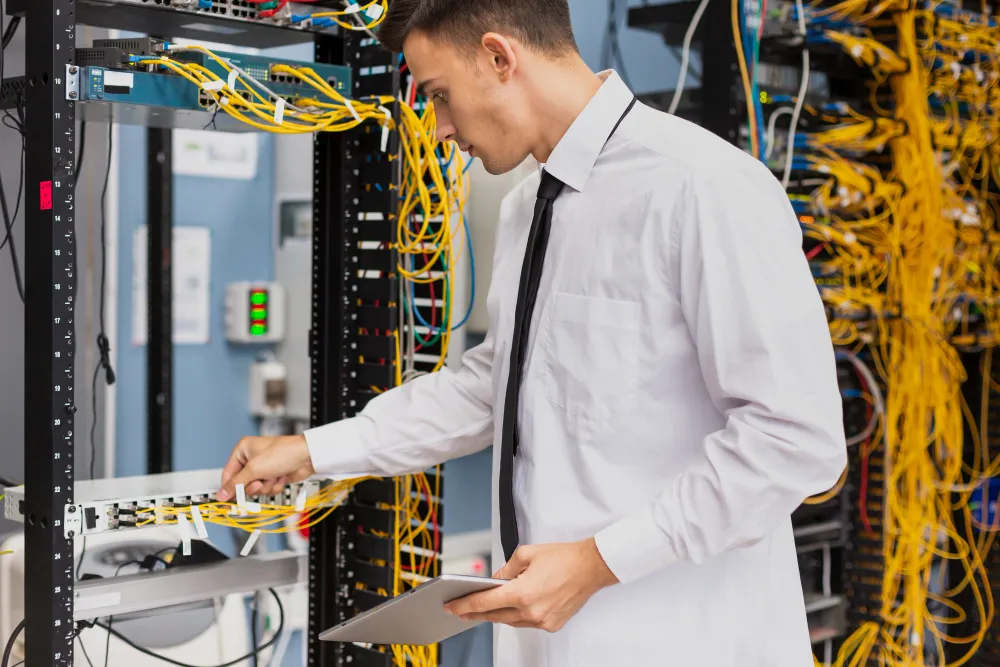Imagine arriving at work one morning and finding your entire company’s data locked behind an encrypted wall, with cybercriminals demanding millions in ransom. This nightmare scenario isn’t just a plot from a tech thriller—it’s becoming an increasingly common reality for businesses worldwide. In 2024 alone, cybercrime caused global damages exceeding $10.5 trillion, and experts predict this figure will only climb higher.
The threat landscape is evolving at a breakneck pace. While organisations rush to digitise their operations and embrace remote work, cybercriminals are developing increasingly sophisticated methods to breach these digital fortresses. From devastating ransomware attacks that can bring entire corporations to their knees to subtle phishing schemes that exploit human psychology, the dangers lurking in our interconnected world have never been more serious.
But here’s the good news: understanding and implementing robust cybersecurity measures can transform your organisation from an easy target into an impregnable fortress. In this comprehensive guide, we’ll dive deep into the world of cybersecurity, exploring everything from fundamental principles to trends that will shape the digital security landscape in 2025 and beyond. Whether you’re a business owner, IT professional, or simply someone who wants to protect their digital assets, this article will equip you with the knowledge and strategies you need to stay one step ahead of cyber threats.
What is Cyber Security?
Cybersecurity refers to the protection of internet-connected devices, services, and data from cyberattacks by hackers, spammers, and cybercriminals. It aims to prevent incidents like phishing schemes, ransomware attacks, data breaches, identity theft, and financial losses. Commonly referred to as IT security or electronic information security, it is a critical shield for businesses in today’s digital era.
In Australia, the Australian Cyber Security Centre (ACSC) outlines four key principles for organisations to strengthen their cybersecurity posture:
- Govern: Establish and enforce security governance.
- Guard: Implement protective controls to safeguard systems.
- Detect: Monitor for cybersecurity incidents.
- Respond: Develop and execute response plans.
Common Cyber Threats
Some of the most common cyber threats include:
- Ransomware: They are the malware (malicious software) that scrambles your data and then demands a ransom in exchange for a key to open it.
- Phishing: It includes the fraudulent practice of sending emails to induce individuals to reveal personal information like credit card numbers.
- Data breaches: Here, information is stolen or taken from a system without the authorisation of the system’s owner.
- Hacking: It includes gaining unauthorised access to data in a system or computer.
- Insider threats: Threats from inside the company or human errors
Status of CyberSecurity in the World and Australia
Globally, cybersecurity threats are escalating both in frequency and sophistication. In 2024, cyberattacks surged by 75%, with organisations experiencing an average of 1,876 attacks per week. High-profile ransomware incidents, data breaches, and phishing scams are becoming common, targeting businesses across industries. Emerging technologies, such as AI and 5G, have expanded the attack surface, while geopolitical tensions have fueled state-sponsored cyberattacks.
In Australia, the cybersecurity landscape mirrors global trends, with an alarming increase in cyber incidents. The Australian Cyber Security Centre (ACSC) reports that cybercrime is reported every seven minutes, costing businesses billions annually. Small and medium-sized enterprises (SMEs) are particularly vulnerable due to limited resources and outdated security systems. The rise of remote work and IoT adoption has further amplified security challenges.
To combat these threats, Australia has implemented stringent cybersecurity measures, including the Essential Eight mitigation strategies and increased funding for the ACSC. However, businesses must also take proactive steps, such as adopting advanced technologies, enhancing employee training, and partnering with reliable IT service providers, to stay protected in this evolving threat landscape.
Top 12 Emerging Cybersecurity Trends in 2025
The cybersecurity geography is evolving rapidly, with new technologies and strategies designed to combat the ever-growing threats. Here are the top 12 cybersecurity trends to watch in 2025:
Artificial Intelligence and Machine Learning
AI and Machine Learning (ML) are already transforming the way businesses approach threat detection and incident response. These technologies can analyse vast amounts of data in real-time, identifying patterns and anomalies that may indicate a security breach. ML algorithms can learn from previous attacks, continuously improving their ability to predict and neutralise new threats.
For NSWITs, implementing AI-powered security solutions can significantly enhance threat detection accuracy and response time, reducing reliance on human intervention and enabling quicker mitigation of security incidents.
AI-driven SIEM (Security Information and Event Management) systems can monitor network traffic, automatically detecting and flagging suspicious activity such as unusual login attempts or abnormal data transfers.
Want to learn more about how AI and Machine Learning are reshaping IT management? Download our comprehensive ebook to discover real-world applications and strategies. [Get your free copy here].
Zero Trust Architecture
Zero Trust Architecture (ZTA) is a cybersecurity model that assumes no one—whether inside or outside the organisation—is trusted by default. Access to systems and data is granted based on strict identity verification and continuous monitoring of user activities. As cybercriminals increasingly target internal networks and insiders, Zero Trust has become a critical strategy for businesses worldwide.
Some key features of Zero-Trust Architecture include:
- Context-Aware Access
- Exhaustive logs of every device on the network,
- Strong user identities for those who use them,
- Authentication at numerous levels
- Real-time health and status reports on devices
Act now to protect your business from costly cyberattacks. Our cybersecurity experts are here to help you implement proactive security measures and fortify your defences. Contact us.
Cloud Security Advancements and New Protocols
With more businesses moving to the cloud, securing these environments has never been more critical. Advances in cloud security, such as enhanced encryption, multi-cloud security management, and new protocols like Cloud Security Posture Management (CSPM), are helping businesses better protect their data and applications.
CSPM tools monitor cloud configurations to ensure compliance with security best practices and automatically remediate misconfigurations that could lead to vulnerabilities.
Quantum computing
Quantum computing has the potential to break current encryption methods, threatening the security of sensitive data. While quantum computing is still in its early stages, businesses should begin preparing for its impact by exploring quantum-resistant encryption algorithms that can safeguard data once quantum computers become widely available.
Post-quantum cryptography (PQC) algorithms are being developed to protect data against quantum threats and are being tested for real-world applications.
Rise of IoT Security on a 5G Network
The Internet of Things (IoT) and 5G architecture are expanding; however, in-depth research is necessary to spot network security gaps and defend the system from attacks. Employees access sensitive information on their mobile devices, including laptops, tablets, and phones, to stay connected, which introduces new cybersecurity challenges.
However, IoT devices inherently have weaker security protections and require less frequent authentication. These devices can serve as entry points for cybercriminals if not adequately secured, making it essential for businesses to implement robust IoT security measures. In addition, improved security must be created, kept up to date, and made the norm for IoT and linked devices in order to protect users. Furthermore, IoT’s fit into blockchain technology is trending as it eliminates the threat of third-party systems opening up doors for data and information leakage.
Secure Software Development Practices (DevSecOps)
DevSecOps integrates security into the software development lifecycle, ensuring that security is a priority from the earliest stages of design. This shift helps identify and address vulnerabilities early, reducing the risk of security flaws in production environments.
Automated security testing tools can be integrated into continuous integration/continuous deployment (CI/CD) pipelines to detect vulnerabilities during development.
Social Engineering Attacks
As per Kaspersky, Social engineering is a deception method that takes advantage of human error to obtain sensitive data, access, or assets. Here, behavioural analytics are used to manipulate people’s minds. Users may compromise their security or divulge private information as a result of this. Scams are already spreading on messaging platforms like WhatsApp and others to trick workers into installing malware on their phones. Thus, scams and voice phishing (vishing) can target both executive leadership and lower-level staff.
Whatever the trends are, companies should stay updated about the issues and possible security measures and help organisations keep their data intact, safe, and uncorrupted.
Concerned about evolving cyber threats? Contact us today to learn how our advanced cybersecurity services can safeguard your business against ransomware, phishing, and other risks.
Remote Work Threats
Now, more people are using Homes as their offices, and they are often less protected than centralised offices, which own secure firewalls, routers, and access management run by IT security teams. These people rely on traditional security, giving cybercriminals a chance to take advantage. Another thing is that employees are using their devices to access their details(social media) and professional life (use of apps like Microsoft Teams and Zoom).
This, thus, increases the risk that sensitive information could fall into the wrong hands. Hence, a critical cyber security trend is for organisations to focus on the security challenges of distributed workforces.
Role of Automation and Managed Services
The cybersecurity talent shortage continues to challenge many businesses. To address this, many organisations are turning to automation and managed security services providers (MSSPs) to help bridge the gap and maintain robust security operations.
Managed services can provide round-the-clock monitoring and rapid response, while automation tools can handle repetitive tasks like threat analysis and patching.
Enhanced Identity and Access Management (IAM) Solutions
IAM solutions are evolving rapidly, providing better ways to manage user identities, permissions, and access to sensitive data. The latest IAM tools leverage biometrics, adaptive authentication, and AI-driven threat intelligence to protect against unauthorised access.
Multi-factor authentication (MFA) combined with AI-driven anomaly detection can ensure that only authorised users gain access to sensitive systems.
Cyber-crime-as-service
Cybercrime as a Service (CaaS) involves seasoned cybercriminals creating products or services that are offered for purchase or rental by others; newer or less skilled cyber criminals frequently purchase these. Attackers can now buy or rent the tools they need to launch their malicious malware or a dark web attack thanks to CaaS. Less effort is spent developing the tools, which frees up more time to organise a successful attack and investigate the businesses most likely to pay the ransom.
In reality, cloned credit cards, PayPal accounts, falsified documents, compromised social media accounts, ransomware, and DDoS attacks can all be purchased and accessed for less than $100. Ransomware-as-a-Service and DDoS (Denial of Service) are two of the most well-known CaaS instances.
By flooding a server with tens of thousands of requests per second, DDoS-as-a-Service attempts to bring down a website, rendering it permanently inoperable unless a ransom is paid. In Ransomware-as-a-Service, distributing tested ransomware and receiving a commission from each successful extortion is done.
Increased Focus on Privacy Laws and Regulatory Changes
With rising concerns over personal data security, governments worldwide are tightening privacy laws. For NSWITs, staying compliant with regulations like the GDPR (General Data Protection Regulation) and Australia’s Privacy Act is becoming increasingly important to avoid heavy fines and reputational damage.
Organisations must adopt robust data privacy practices, ensuring that customer data is handled according to legal requirements.
What is the Future of Cybersecurity?
As more people are online, the concern about cybersecurity will grow in 2025 as well. Companies would focus more on preventing, detecting and reacting to cyber threats and attacks. The use of vCISOs will be done to uncover the weaknesses in automated security systems and put measures in place to make them more secure. Businesses will implement more thorough plans of action in the case of attacks.
Internal regulations and training employees about cyber security will be made compulsory. Another thing is that businesses will set up their cybersecurity foundation; further, it will be rigorously tested. Likewise, investment in security tools will be made for malware protection, including preventing the level of dangerous disinformation and malicious attacks.
Don’t wait for a breach to take action. Contact us today to secure your business with expert solutions that protect your data, customers, and reputation.
Tips to Ensure Better Cybersecurity
- Be wary of suspicious links and email attachments.
- Regularly update your passwords and use a password manager.
- Enable multi-factor authentication (MFA) for added security.
- Consider alternatives to debit cards for added protection.
- Keep systems updated to avoid security vulnerabilities.
- Stick to reputable websites and control your social media exposure.
- Utilise IAM and SIEM tools for better access management and intrusion detection.
Conclusion: Preparing for 2025 and Beyond
In 2025, cybersecurity is expected to evolve rapidly. By staying informed on the latest technologies and trends, NSWITs can help businesses mitigate risks and strengthen their defences. Now is the time to embrace advanced security measures that provide proactive protection, compliance with local laws, and robust data security.
To ensure your business stays ahead of the curve, consider reaching out to your trusted cybersecurity partner for guidance. As a leading IT support company in Australia, NSWIT Support always ensures that services are provided that incorporate the use of the latest cybersecurity technologies. We also offer cybersecurity consulting to help you learn more about available security functions, security products, and many more. Contact us for further information on our cybersecurity or any of our IT Services.










